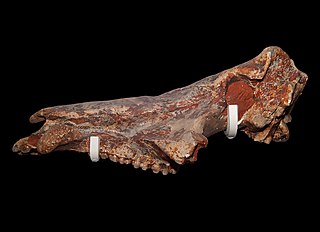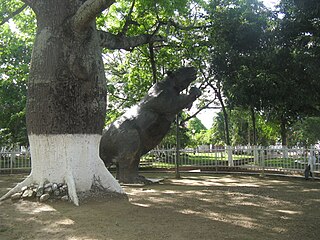
Carcharhinus is the type genus of the family Carcharhinidae, the requiem sharks. One of 12 genera in its family, it contains over half of the species therein. It contains 35 extant and eight extinct species to date, with likely more species yet to be described.

The Itaboraian age is a period within the Early Eocene geologic time epoch of the Paleogene, used more specifically with South American land mammal ages (SALMA). It follows the Riochican and precedes the Casamayoran age.
The Riochican age is a period of geologic time within the Paleocene and Eocene epochs of the Paleogene, used more specifically within the South American land mammal ages (SALMA). It follows the Peligran and precedes the Itaboraian age.
The Casamayoran age is a period of geologic time within the Early Eocene epoch of the Paleogene, used more specifically within the South American land mammal age (SALMA) classification. It follows the Itaboraian and precedes the Mustersan age.
The Laventan age is a period of geologic time within the Middle Miocene epoch of the Neogene, used more specifically within the SALMA classification in South America. It follows the Colloncuran and precedes the Mayoan age.
The Huayquerian age is a period of geologic time within the Late Miocene epoch of the Neogene, used more specifically within the SALMA classification. It follows the Chasicoan and precedes the Montehermosan age.

Chelonoidis is a genus of turtles in the tortoise family erected by Leopold Fitzinger in 1835. They are found in South America and the Galápagos Islands, and formerly had a wide distribution in the West Indies.

Hippohyini was an extinct tribe of Suinae which existed in Asia during the Pliocene.
Cainochoerinae was a subfamily of even-toed ungulates that existed during the Miocene and Pliocene in Asia and Africa.

Hyotheriinae was a subfamily of even-toed ungulates that existed during the Miocene and Pliocene in Europe, Asia, and Africa.
Parachleuastochoerus was an extinct genus of even-toed ungulates that existed during the Miocene in Europe. It was a smaller descendant of the Conohyus genus, with narrower cheek teeth and reduced premolars.
Tetraconodon was an extinct genus of even-toed ungulates that existed during the middle and late Miocene in Asia.
Namachoerus was an extinct genus of even-toed ungulates that existed during the Miocene of Africa.

Eumaiochoerus is an extinct genus of even-toed ungulates that existed during the Miocene in Italy.
Korynochoerus is an extinct genus of even-toed ungulates that existed during the Miocene in Europe and Asia Minor.

Microstonyx was an extinct genus of suid that existed during the Miocene in Asia and Europe.

The Honda Group is a geological group of the Upper and Middle Magdalena Basins and the adjacent Central and Eastern Ranges of the Colombian Andes. The group, in older literature also defined as formation, is in its present-day type section in the Tatacoa Desert in the department of Huila subdivided into two main formations; La Victoria and Villavieja.

The Hiló Formation is a geological formation of the Altiplano Cundiboyacense, Eastern Ranges of the Colombian Andes. The predominantly shale formation dates to the Middle Cretaceous period; Late Albian to Early Cenomanian epochs and has a measured thickness at its type section of 470 metres (1,540 ft). The fossiliferous formation has provided a great abundance of ammonites and other marine species.










